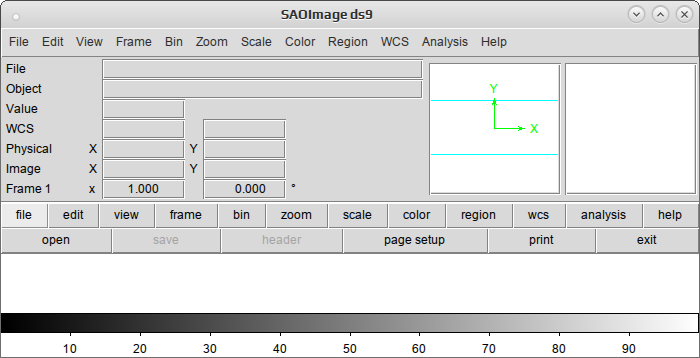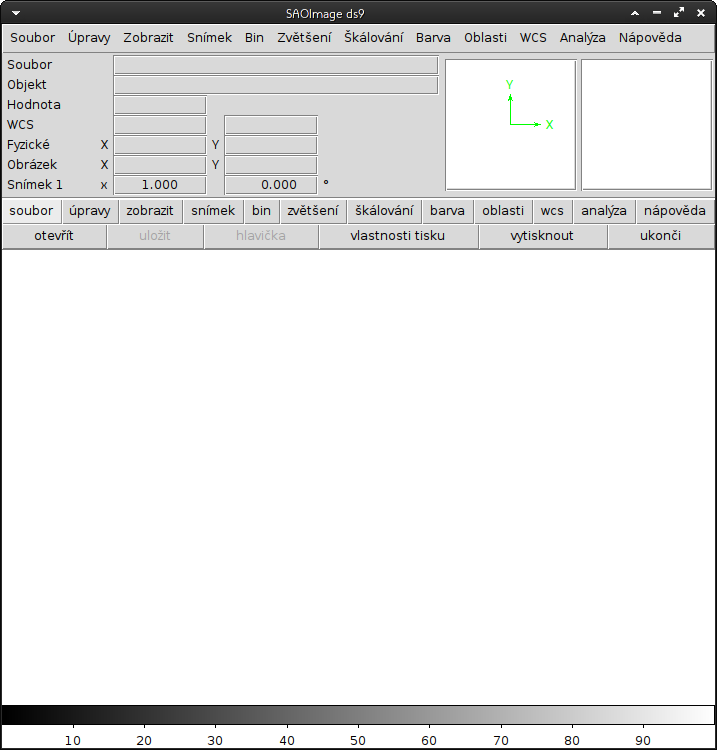

However, the log scaling function in SAOimage divides the selected intensity range into 200 linearly spaced levels before taking the log. If you want to display an image with greater dynamic range, you may prefer to use logarithmic scaling.

You can use these starting points in estimating reasonable values for the minimum and maximum intensity display parameters. Notice in figure 3.2 that when you run display, the task shows you the z1 and z2 values that it calculates. To customize your minimum and maximum intensity display values, set zscale-, zrange-, z1 to the minimum value and z2 to the maximum value that you want displayed. Setting zscale- and zrange+ tells the task to use minimum and maximum values from the image as the minimum and maximum intensity values. The zscale parameter toggles the autoscaling. During your first look, you may want to experiment with the scaling using the zscale, zrange, z1 and z2 parameters. By default, display automatically scales the image intensity using a sampling of pixels throughout the image. The example in figure 3.2 shows how you should display an image for a first look. On-line help is also available at the system level: type man saoimage in Unix or help saoimage in VMS. Just click on the buttons to scale, pan, or print the image, or to perform other commonly-used functions. The SAOimage Users Guide describes these commands, although most are fairly intuitive. Once an image appears in your SAOimage window, you can use the SAOimage commands displayed near the top of the image window to manipulate or print your image. Use the SAOimage command buttons that control zooming, panning, etc.There are two ways to adjust how your image is displayed: If you want to display all four chips of a WF/PC-1 or WFPC2 image simultaneously, you can create a mosaic with the STSDAS wmosaic task in the hst_calib.wfpc package.
#Saoimage ds9 scale parameters how to
figure 3.2 shows how to display group two of a WF/PC-1 image. However, when working with FITS files you must specify an extension, unless the FITS file contains only a single image in the primary data unit and has no extensions. Note that when using display or any other task on GEIS images, you do not need to specify a group the first group is the default. Tv> display fname.fits 1 (FITS extension sci,3)

Tv> display fname.fits 1 (FITS extension 11) Display the image with the IRAF display task, using the syntax appropriate for the file format ( chapter 2 explains how to specify GEIS groups and FITS extensions):.Several different display servers, including SAOimage, ds9 (the next generation of SAOimage), and Ximtool, can be used with IRAF. Load the package from the window where you're running IRAF:.Start an image display server, such as SAOimage, in a separate window from your IRAF session, either from a different xterm window or as a background job before starting IRAF.The most general IRAF task for displaying image data is the display task, the best choice for a first look at HST imaging data. The FOC photon-counting hardware does not detect cosmic rays at easily as CCDs, the NICMOS pipeline automatically removes cosmic rays from MULTIACCUM observations, and the STIS pipeline automatically removes cosmic rays from CR-SPLIT association products. Observers viewing WF/PC-1 and WFPC2 data may wish to remove cosmic rays before displaying their data. How to display images in IRAF using the display task.This section will be of interest primarily to observers whose datasets contain two-dimensional images, as it explains:


 0 kommentar(er)
0 kommentar(er)
